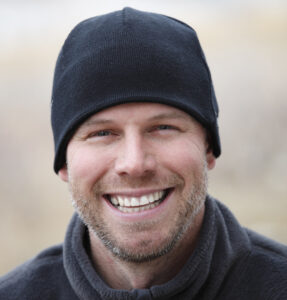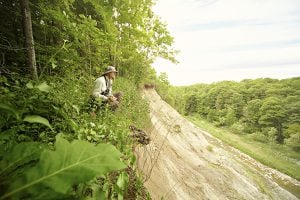By 8:30 a.m., I had wolves moving all around in front of me. Pups frolicking in the tall grasses to my left and adults sauntering through the trees at the back of the ridge directly ahead of me. I was both thankful and exhilarated to see so many wolves and to see them all looking so healthy, with resplendent, shimmering summer coats and fat, full bellies. The pups were constantly playing and chasing each other, which was another sign that the spring had been very good to the family.
As I sat there silently trying to get photos, I wondered where the wolves had spent the spring. I was now sure that they were moving south out of the park following the deer migration to lower elevations in the winter, but where were they denning? I had analyzed Google Earth a thousand times trying to figure out potential denning spots throughout the park and had visited most of them only to be skunked.
I decided to call Gudrun Pflueger, who had worked with an isolated population of coastal wolves with the Raincoast Conservation Foundation during summers in the early 2000s and simultaneously independently studied wolves living in Kootenay National Park during winters while working at Nipika Mountain Resort on the southern boundary of the park.
Gudrun told me how she had often followed the wolves out of the park in the winter to the south and that she had closely monitored a wolf trapping site less than a kilometre outside of the national park for several years. She also described the den site she had monitored, including the lookout point she had used to observe the wolves at the den. I had investigated it the previous fall, but had not found any evidence that it had been used for years. Still, I decided to spend a few days in late April and early May 2015 at Gudrun’s lookout on the off-chance Whitey and the gang might show up. Unfortunately, I came up empty handed.
At 9:30 a.m., a wolf pup at Waydeep began to wan- der right toward me. It had been playing tag with its siblings and I had lost sight of it in a thick patch of bush. I suddenly realized that it was coming through the vegetation right at me just 30 metres away. Rather than risk having it walk right up to me, I called out softly.
“Hey buddy.”
The pup froze. It looked around briefly, then started toward me again.
“Hey buddy,” I said, a little louder.
Again, the pup froze. It stared right at my lens through a tangle of twigs and greenery. I fired a series of shots and the light clicks from my supposedly quiet camera made the pup’s ears twitch. When it started forward yet again, I peered out from behind my camera so the pup could clearly see my head move and calmly said, “Look buddy, I don’t think you should walk over here.”







